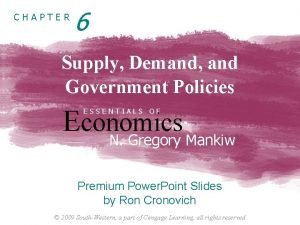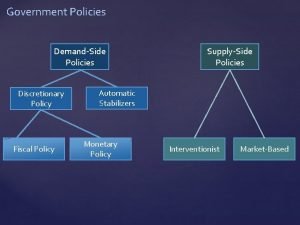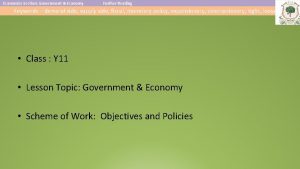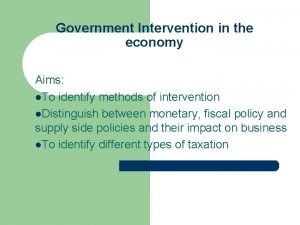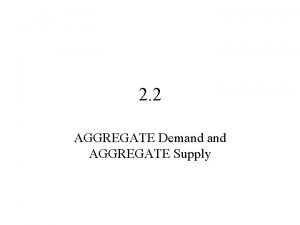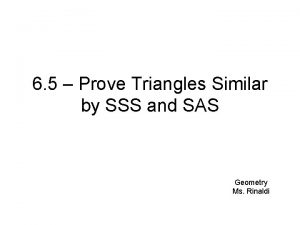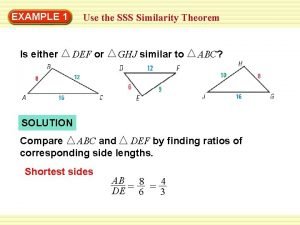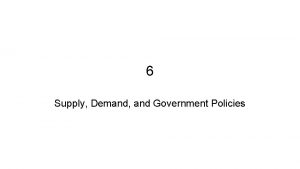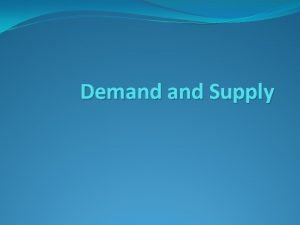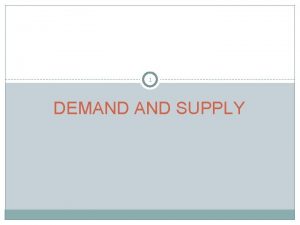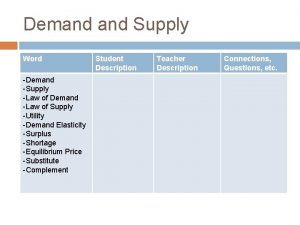Demand Supply Side Policies I Government DemandSide Policies







- Slides: 7

Demand & Supply Side Policies

I. Government & Demand-Side Policies i. Demand-side policies advocate the use of gov’t spending and taxation to control aggregate demand stabilize the economy. a. Role of Gov’t i. Keynes proposed an active role for gov’t in the expansionary economy. Said that the federal gov’t should step in and use fiscal policy to promote full employment. 1. Wanted increase in gov’t spending to help create jobs and increase income, also wanted decrease in taxes to encourage spending and investing. ii. Also thought that during times of inflation, the gov’t should contractionary fiscal policy to keep prices from rising.

b. Analysis of Demand-Side Policies i. In certain circumstances, increase gov’t spending may lead to economic recovery. Ex: spending $ on public works & programs and on production related to WWII brought the US out of the Great Depression. 1. It can be a challenge to limit spending or terminate programs later. ii. Excessive aggregate demand due to gov’t or consumer spending can lead to inflation, and contractionary policies are usually needed, which means cutting gov’t spending or raising taxes. 1. Some politicians may choose not to increase taxes or cut spending because it will be unpopular and they might not get reelected because of it.

II. Supply-Side Economics i. Some economists believe that the best way to influence the economy is through the supply side, rather than demand. Supply-side fiscal policy: provides incentives to producers to increase aggregate supply. 1. Focuses on cutting the cost of production to encourage producers to supply more.

III. The Role of Government in Supply-Side i. Favors less gov’t involvement in the 3 ways that they can have influence: taxation, spending, and regulation. a. Taxes. Favor cutting tax rates because they believe that high tax rates slow economic growth by discouraging working, saving and investing. i. By reducing the highest tax brackets provides more available income to people most likely to invest in new business activities. b. Spending. If the gov’t spends less, it needs to take in less revenue and then it is able to lower taxes. c. Regulation. Gov’t regulation can add to the costs of production and make it harder for businesses to grow. Deregulation, cuts costs and leads to increases in aggregate supply.

IV. Analysis of Supply-Side Fiscal Policy a. Often referred to as Reaganomics or trickle-down economics. It comes from the idea that tax incentives that benefit higher income taxpayers and businesses will stimulate the economy in such a way that all taxpayers benefit. i. Businesses will use that extra money to expand their business and will need to hire more people—Hobo Joe.

V. Pros & Cons a. Demand Side Fiscal Policy i. Pro: provides direct and almost immediate need to those who need it. ii. Con: not a long term solution b. Supply Side Fiscal Policy i. Pro: provides long term solution to problems like unemployment ii. Con: not always guaranteed that those that need the money will get it. c. Overall, neither policy solves the problem on its own. You would need a combination of both policies.
